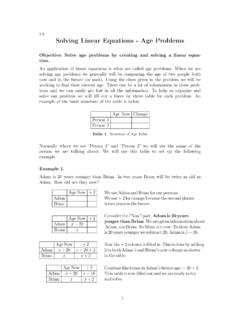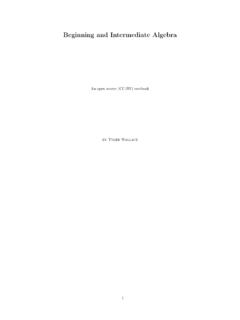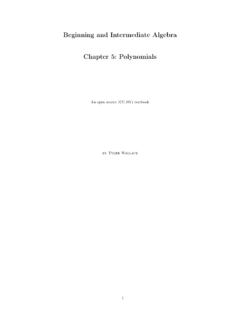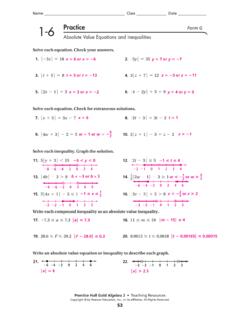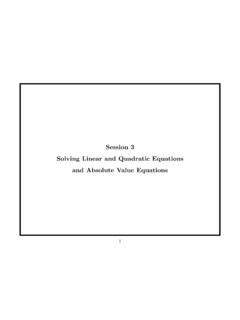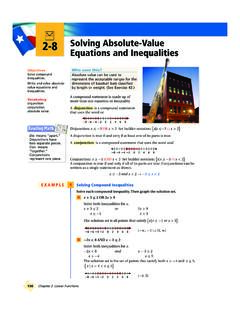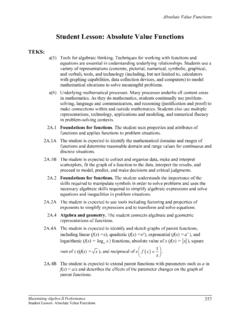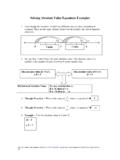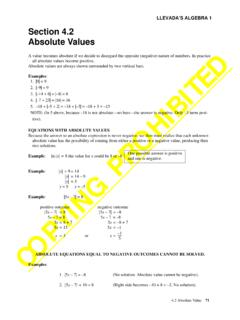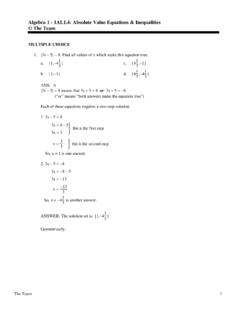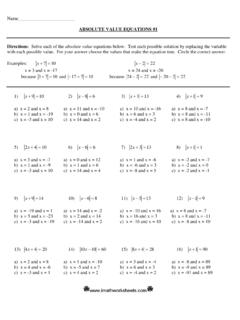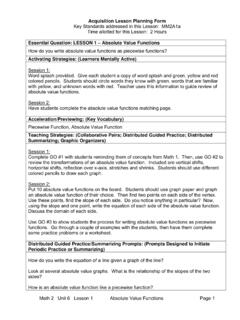Transcription of Solving Linear Equations - Absolute Value
1 Linear Equations - Absolute ValueObjective: Solve Linear Absolute Value Solving Equations with Absolute Value we can end up withmore than onepossible answer. This is because what is in the Absolute Value can be either nega-tive or positive and we must account for both possibilities when Solving is illustrated in the following 1.|x|= 7 Absolute Value can be positive or negativex= 7orx= 7 Our SolutionNotice that we have considered two possibilities, both the positive and way, the Absolute Value of our number will be View Note:The first set of rules for working with negatives came from7th century India.
2 However, in 1758, almost a thousand yearslater, British math-ematician Francis Maseres claimed that negatives Darken the very whole doc-trines of the Equations and make dark of the things which are in their natureexcessively obvious and simple. When we have Absolute values in our problem it is important tofirst isolate theabsolute Value , then remove the Absolute Value by considering both the positiveand negative solutions. Notice in the next two examples, allthe numbers outsideof the Absolute Value are moved to the other side first before we remove the abso-lute Value bars and consider both positive and negative +|x|= 8 Notice Absolute Value is not alone 5 5 Subtract5from both sides|x|= 3 Absolute Value can be positive or negativex= 3orx= 3 Our SolutionExample 3.
3 4|x|= 20 Notice Absolute Value is not alone 4 4 Divide both sides by 41|x|= 5 Absolute Value can be positive or negativex= 5orx= 5 Our SolutionNotice we never combine what is inside the Absolute Value with what is outsidethe Absolute Value . This is very important as it will often change the final resultto an incorrect solution. The next example requires two steps to isolate the abso-lute Value . The idea is the same as a two-step equation, add orsubtract, thenmultiply or |x| 4 =26 Notice the Absolute Value is not alone+ 4 + 4 Add4to both sides5|x|=30 Absolute Value still not alone55 Divide both sides by5|x|= 6 Absolute Value can be positive or negativex= 6orx= 6 Our SolutionAgain we see the same process, get the Absolute Value alone first, then considerthe positive and negative solutions.
4 Often the Absolute Value will have more thanjust a variable in it. In this case we will have to solve the resulting equationswhen we consider the positive and negative possibilities. This is shown in the 5.|2x 1|= 7 Absolute Value can be positive or negative2x 1 = 7or2x 1 = 7 Two Equations to solveNow notice we have two Equations to solve, each equation willgive us a differentsolution. Both Equations solve like any other two-step 1 = 7+ 1 + 12x= 822x= 4or2x 1 = 7+ 1 + 12x= 622x= 32 Thus, from our previous example we have two solutions,x= 4orx= , it is important to remember that the Absolute Value must be alone firstbefore we consider the positive and negative possibilities.
5 This is illustrated 4|2x+ 3|= 18To get the Absolute Value alone we first need to get rid of the2by subtracting,then divide by 4. Notice we cannot combine the2and 4becuase they arenot like terms, the 4has the Absolute Value connected to it. Also notice we donot distribute the 4into the Absolute Value . This is because the numbers out-side cannot be combined with the numbers inside the absolutevalue. Thus we getthe Absolute Value alone in the following way:2 4|2x+ 3|= 18 Notice Absolute Value is not alone 2 2 Subtract2from both sides 4|2x+ 3|= 20 Absolute Value still not alone 4 4 Divide both sides by 4|2x+ 3|= 5 Absoloute Value can be positive or negative2x+ 3 = 5or2x+ 3 = 5 Two Equations to solveNow we just solve these two remaining Equations to find our + 3 = 5 3 32x= 222x= 1or2x+ 3 = 5 3 32x= 822x= 4We now have our two solutions,x= 1andx= we are Solving Absolute Value Equations it is important tobe aware of specialcases.
6 Remember the result of an Absolute Value must always be positive. Noticewhat happens in the next +|2x 5|= 4 Notice Absolute Value is not alone 7 7 Subtract7from both sides|2x 5|= 3 Result of Absolute Value is negative!Notice the Absolute Value equals a negative number! This is impossible with abso-lute Value . When this occurs we say there isno solutionor .One other type of Absolute Value problem is when two absolutevalues are equal toeachother. We still will consider both the positive and negative result, the differ-ence here will be that we will have to distribute a negative into the second abso-lute Value for the negative 8.
7 |2x 7|=|4x+ 6| Absolute Value can be positive or negative2x 7 = 4x+ 6or2x 7 = (4x+ 6)makesecondpartofsecondequationnegative Notice the first equation is the positive possibility and hasno significant differ-ence other than the missing Absolute Value bars. The second equation considersthe negative possibility. For this reason we have a negativein front of the expres-sion which will be distributed through the equation on the first step of Solving . Sowe solve both these Equations as follows:2x 7 = 4x+ 6 2x 2x 7 = 2x+ 6 6 6 13= 2x22 132=xor2x 7 = (4x+ 6)2x 7 = 4x 6+ 4x+ 4x6x 7 = 6+ 7 + 76x= 166x=16 This gives us our two solutions,x= 132orx= and Intermediate Algebra by Tyler Wallace is licensed under a Creative CommonsAttribution Unported License.
8 ( ) Practice - Absolute Value EquationsSolve each )|x|= 83)|b|= 15)|5 + 8a|=537)|3k+ 8|= 29)|9 + 7x|=3011)|8 + 6m|=5013)|6 2x|=2415) 7| 3 3r|= 2117)7| 7x 3|=2119)| 4b 10|8= 321)8|x+ 7| 3 = 523)5|3 + 7m|+ 1 =5125)3 + 5|8 2x|=6327)|6b 2|+10=4429) 7 + 8| 7x 3|=7331)|5x+ 3|=|2x 1|33)|3x 4|=|2x+ 3|35)|4x 25|=|6x+ 32|2)|n|= 74)|x|= 26)|9n+ 8|=468)|3 x|= 610)|5n+ 7|=2312)|9p+ 6|= 314)|3n 2|= 716)|2 + 2b|+ 1 = 318)| 4 3n|4= 220)8|5p+ 8| 5 =1122)3 |6n+ 7|= 4024)4|r+ 7|+ 3 =5926)5 + 8| 10n 2|=10128)7|10v 2| 9 = 530)8|3 3n| 5 =9132)|2 + 3x|=|4 2x|34)|2x 53|=|3x+ 42|36)|3x+ 22|=|2x 33|Beginning and Intermediate Algebra by Tyler Wallace is licensed under a Creative CommonsAttribution Unported License.
9 ( ) to Absolute Value Equations1) 8, 82)7, 73)1, 14) 2, 25) 6, 2946)389, 67) 2, 1038) 3,99) 3, 39710)165, 611) 7, 29312) 13, 113) 9,1514)3, 5315) 2,016) 0, 217) 67,018) 4,4319) 172,7220) 65, 221) 6, 822)6, 25323) 1, 13724)7, 2125) 2,1026) 75,127) 6, 16328)25,029) 137,130) 3,531) 43, 2732) 6,2533)7,1534) 225, 21335) 1922, 113836)0, 125 Beginning and Intermediate Algebra by Tyler Wallace is licensed under a Creative CommonsAttribution Unported License. ( )6


